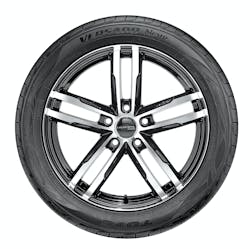The impact of plus-sizing on vehicle performance dynamics
Is bigger better? Does a wider footprint always translate into better handling?
Every day, consumers ask retail tire dealers these questions:
- “Will plus-sizing my vehicle’s tires make my car handle better?”
- “Will I get better traction?”
- “Will that give me a harder ride?”
The Specialty Equipment Market Association (SEMA) Wheel & Tire Council (WTC) and Clemson University’s International Center for Automotive Research (CU-ICAR) together set out to understand the effects of plus-sizing — the dynamics associated with the changing of wheels, offsets, tire sidewall heights, wheel diameters and other associated modifications.
The quest was to specifically and scientifically understand vehicle handling dynamics related to the customization of wheels and tires.
Test subject
The researchers selected a frequently modified vehicle — America’s top-selling truck, the Ford F-150. After months of testing and evaluation at CU-ICAR’s Greenville, S.C., campus, the results were very interesting. Though they supported long-standing industry beliefs, the specifics were eye opening.
In many cases, shorter sidewalls did not translate into a harsher ride. The difference in harshness was less than generally understood and much less than anticipated.
The facts support the idea that customers can have it all — better handling, better directional response, better steering response, better steering firmness and road grip — without sacrificing ride comfort.
Upon receipt of the scientific data, the team at WTC reformatted the data into a usable and understandable format that is consumer-friendly and named it the Ride Guide.
The Ride Guide outlines the basics of plus-sizing, section width, sidewall height and outside diameter, but more importantly, it specifically describes the individual results in a bar graph that is more accurate and predictive of final dynamics after a vehicle wheel and tire modification is completed.
The Ride Guide is just that, a guide that assists aftermarket providers in setting and realizing customer expectations.
Now sales associates can give consumers a definitive answer to their most common question: “Can you tell me before I spend my money how tire and wheel plus-sizing is going to affect the ride quality and handling of my vehicle?”
Since the initial testing of the 2013 Ford F-150, CU-ICAR has tested the 2014 Chevrolet Silverado with similar findings, and they’re just wrapping up results on the 2014 Mazda3. The next target market is the wildly popular American muscle car segment with the first scheduled testing of the new Ford Mustang.
In today’s digital marketplace, information is easily accessible; however, good, reliable and professional information, not so much. The victory goes to the prepared
Those dealerships that deliver the best solutions, the most professional answers and have the ability to master the total customer experience will win both the customer and the business.
A copy of the Ride Guide is available through these sources: SEMA at www.sema.org and the WTC at www.sema.org/wtc. ■
